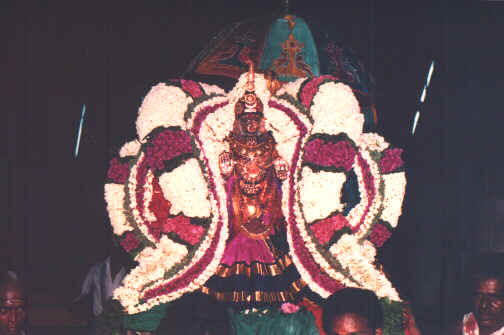Parvati the consort of Shiva is regarded as the mother Goddess Shakti,
a personification of cosmic energy.

Legend has it that Shakti took birth as Daakshaayani or Sati - the
daughter of the mythological Daksha who was
entrusted with the task of propagating the human race. Sati married Shiva against the
wishes of her father and the vain king performed a great yagna with the sole purpose of
insulting Shiva. To this yagna, Daksha invited all of the gods and goddesses with the
exception of Shiva. Against Shiva's wishes Sati attended this sacrifice, was insulted by
father; unable to bear the insult Sati immolated herself in the sacrificial altar.
Enraged at the insult and injury Shiva through Veerabhadra destroyed
Daksha's sacrifice, severed Daksha's head and replaced it with that of a goat and restored
him to life. Crazed with grief, he picked up the remains of Sati's body and engaged
himself in the dance of destruction throughout the Universe. The disk of Vishnu cut
through Sati's corpse and scattered her remains throughout the Indian subcontinent at
sites that are now known as the Shakti Peethams.
Sati was reborn as Parvati, the daughter of the mountain king Himavat and after rigorous
penance married Shiva. To this couple was born Kumara or Skanda the would-be destroyer of Tarakasura
and other demons. All of these legends are woven around Shakti, Shiva and Skanda,
the trinity that constitute Somaskanda,
the symbol of prosperity and propagation of life.
Parvati in the form of Gowri is the gentle consort of Shiva and is
representative of the caring benevolent, matronly aspects of nature. South Indian Saivite
shrines inevitably have a shrine dedicated to Parvati. Iconographic portrayals of Shiva in
the form of Somaskanda, Chandrasekhara etc., portray
Parvati adjacent to Shiva.
Thus, Sivakaami is the consort of Shiva Nataraja; Meenakshi is the consort of
Sundareswara and so on. In certain Saivite temples, an image of Bhoga Sakthi is enshrined
within the sancta enshrining presiding deity Shiva in the form of a Shivalingam.
Somaskanda thus depicts
Shiva as a householder while Dakshinamurthy -
yet another manifestation of Shiva depicts him as a yogi.
Further more, the Ardhanaareeswara
manifestation of Shiva is symbolic of the interconnectedness of matter and energy, wherein
Parvati is portrayed as being a part of Shiva,; Ardhanaareeswara is portrayed as being
half male and half female.
These apart, there are countless temples dedicated to Shakti-Parvati alone
all over the Indian subcontinent. .

